© Copyright Atlanta Coin Expositions, 2008-2025. All Rights Reserved.
Several of the links on the pages within this web site go to affiliate vendors.
A vendor affiliation can mean a small monetary compensation to the web site owner at no additional cost to you.
Several of the links on the pages within this web site go to affiliate vendors.
A vendor affiliation can mean a small monetary compensation to the web site owner at no additional cost to you.
Coin Show
Information
Shop
General
Next Monthly Coin Show
Coin Show - Monthly Notes from February 2019
The February 2019 Greater Atlanta Coin Show filled the hotel's Hamilton's restaurant with dealers, their displays of numismatics and collectibles along with visitors looking to buy, sell, trade or just browse among the treasures.
We appreciate all of you - the many visitors, the dealers, our security and the hotel's staff - for making the show a fun and busy place to be each month, even when we are in another part of the hotel's space. And, even when the hotel has a leak from pipes above the ceiling as people saw when they entered the show.
This month, the hotel hosted several different events, the largest was a military gathering that took the ballroom and several of the smaller rooms as well.
Downstairs, they had at least one church, Barbazon modeling and Mary Kay meetings.
We appreciate all of you - the many visitors, the dealers, our security and the hotel's staff - for making the show a fun and busy place to be each month, even when we are in another part of the hotel's space. And, even when the hotel has a leak from pipes above the ceiling as people saw when they entered the show.
This month, the hotel hosted several different events, the largest was a military gathering that took the ballroom and several of the smaller rooms as well.
Downstairs, they had at least one church, Barbazon modeling and Mary Kay meetings.
In other words, the variety of events kept the hotel busy on an overcast, windy February Sunday where the outside temperatures ranged in the upper 30s and low 40s.
As for coins and collectibles, this month some people looked for current silver American eagles while others searched for early walking liberty half dollars. Both of these contain the A. A. Weinman design of Liberty walking into the dawn of a new day.
As for coins and collectibles, this month some people looked for current silver American eagles while others searched for early walking liberty half dollars. Both of these contain the A. A. Weinman design of Liberty walking into the dawn of a new day.
One of our visiting dealers this month showcased jewelry with a display that just glittered under her strategically placed lights. Of course, being before Valentine's Day, the jewelry sparkled as potential gifts for the sweethearts.
Now, let's take a virtual look at some collectibles on the bourse, not many as it was a busy day with very little time for taking snapshots. Notice there is a theme.
Now, let's take a virtual look at some collectibles on the bourse, not many as it was a busy day with very little time for taking snapshots. Notice there is a theme.
Centennial Winter Games Collectible Playing Card Decks

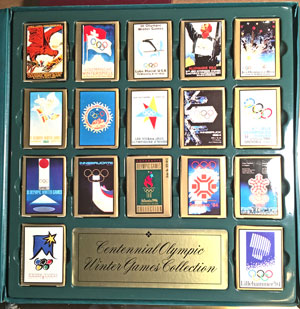
The first item is a collectible set of card decks with each featuring a Winter Olympic venue from 1924 through 1994.
The United States Playing Card Company produced the set for sale and distribution during the centennial year of the modern Olympic games in Atlanta in 1996.
The limited edition, Centennial Olympic Winter Games Collection MicroMini Playing Card Collector's set contains 17 Winter Olympic MicroMini decks.
Each deck measures 1 3/8 inches by 1 7/8 inches, which are contained in a custom leatherette display case.
On the package:
The United States Playing Card Company produced the set for sale and distribution during the centennial year of the modern Olympic games in Atlanta in 1996.
The limited edition, Centennial Olympic Winter Games Collection MicroMini Playing Card Collector's set contains 17 Winter Olympic MicroMini decks.
Each deck measures 1 3/8 inches by 1 7/8 inches, which are contained in a custom leatherette display case.
On the package:
"Limited edition collector's set celebrates the glory of the first 100 years of the modern Olympic era with authentic, historical artwork from 1896 to the present."
"Exclusive MicroMini Playing Card decks feature individual posters, logos and pictograms of Historical Olympic Winter Games on the packages and card backs."
A comparable Summer set contains 24 card decks honoring the summer games.
This set began with 1924 Chamonix, France and continued for the games every four years, except for 1940 and 1944, until the winter games in 1994 Lillehammer, Norway, the last games before the centennial year.
Perhaps this set was purchased at the games in Atlanta.
"Exclusive MicroMini Playing Card decks feature individual posters, logos and pictograms of Historical Olympic Winter Games on the packages and card backs."
A comparable Summer set contains 24 card decks honoring the summer games.
This set began with 1924 Chamonix, France and continued for the games every four years, except for 1940 and 1944, until the winter games in 1994 Lillehammer, Norway, the last games before the centennial year.
Perhaps this set was purchased at the games in Atlanta.
XXVI Olympiad Torch Runner Gold $5 1995

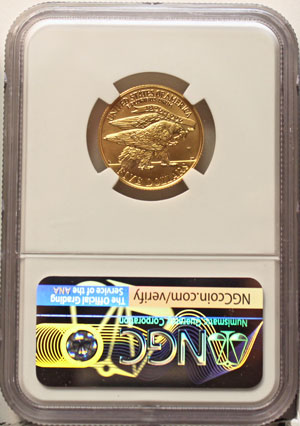
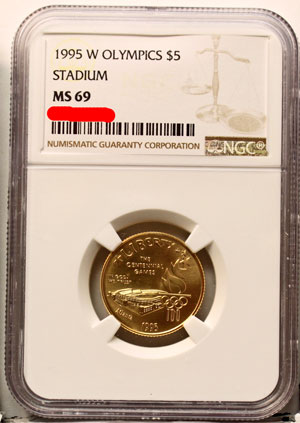
Following the theme of the Centennial Olympic Games, the first coin is a 1995 XXVI Olympiad Torch Runner Gold Five-Dollar coin.
Congress developed legislation, which became Public Law 102-390 on October 6, 1992, for all of the 1995 and 1996 Olympic commemorative coins.
"An Act to provide for the minting of commemorative coins to support the 1996 Atlanta Centennial Olympic Games and the programs of the United States Olympic Committee, to reauthorize and reform the United States Mint and for other purposes.
Congress developed legislation, which became Public Law 102-390 on October 6, 1992, for all of the 1995 and 1996 Olympic commemorative coins.
"An Act to provide for the minting of commemorative coins to support the 1996 Atlanta Centennial Olympic Games and the programs of the United States Olympic Committee, to reauthorize and reform the United States Mint and for other purposes.
The law specified for the Five-Dollar gold coins that they "shall weigh 8.359 grams, have a diameter of 0.850 inches, and contain 90 percent gold and 10 percent alloy, with the dates and in the amounts, as follows:
"1995 - Not more than 175,000 each of two coins of different designs.
"1996 - Not more than 300,000 each of two coins of different designs."
Congress provided guidelines for the designs to "be emblematic of the participation of athletes from the United States of America in the Olympic Games culminating in the 1996 Centennial Games in Atlanta, Georgia."
"1995 - Not more than 175,000 each of two coins of different designs.
"1996 - Not more than 300,000 each of two coins of different designs."
Congress provided guidelines for the designs to "be emblematic of the participation of athletes from the United States of America in the Olympic Games culminating in the 1996 Centennial Games in Atlanta, Georgia."
For this coin, the US Mint described its obverse and reverse:
"The obverse features a design of a torch runner carrying the torch to the cauldron, the Olympic Games logo, and the Atlanta skyline in the background."
"The reverse features a side view of the bald eagle, with a banner in its beak."
This particular coin in its NGC (Numismatic Guaranty Corporation) certified holder is an MS-70 specimen out of a population of only 14,675 uncirculated coins produced.
In other words, a top example of the coin and the design.
"The obverse features a design of a torch runner carrying the torch to the cauldron, the Olympic Games logo, and the Atlanta skyline in the background."
"The reverse features a side view of the bald eagle, with a banner in its beak."
This particular coin in its NGC (Numismatic Guaranty Corporation) certified holder is an MS-70 specimen out of a population of only 14,675 uncirculated coins produced.
In other words, a top example of the coin and the design.
XXVI Olympiad Stadium Gold $5 1995
Our next example is the second Olympic gold commemorative coin for 1995.
For this coin, the US Mint described the design:
"The obverse features a design of the Olympic Stadium of the 1996 Olympic Games and the Olympic Games logo."
"The reverse features a side view of the bald eagle, with a banner in its beak."
NGC certified this coin as an MS-69, not quite as pristine as the Torch Runner, but still a nice specimen.
But, as for the population, this coin is one of just 10,579 uncirculated coins. Under the law, the US Mint could have produced up to 175,000 of the 1995 gold Olympic coins.
Instead, the total production was roughly 36% of the number allowed including proof and uncirculated for the two gold coins in 1995.
Still, though, look at the small populations for these uncirculated coins.
For this coin, the US Mint described the design:
"The obverse features a design of the Olympic Stadium of the 1996 Olympic Games and the Olympic Games logo."
"The reverse features a side view of the bald eagle, with a banner in its beak."
NGC certified this coin as an MS-69, not quite as pristine as the Torch Runner, but still a nice specimen.
But, as for the population, this coin is one of just 10,579 uncirculated coins. Under the law, the US Mint could have produced up to 175,000 of the 1995 gold Olympic coins.
Instead, the total production was roughly 36% of the number allowed including proof and uncirculated for the two gold coins in 1995.
Still, though, look at the small populations for these uncirculated coins.
XXVI Olympiad Flag Bearer Gold $5 1996
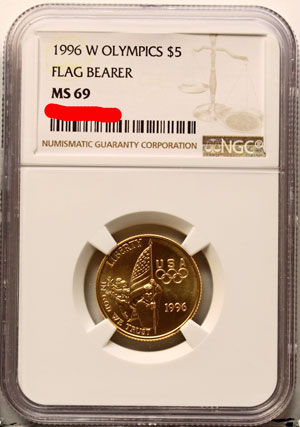

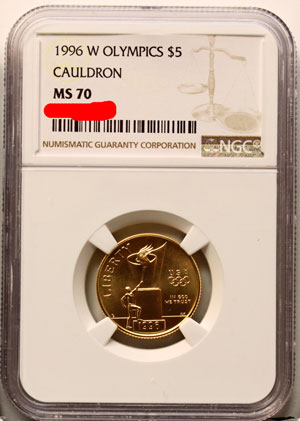
Moving to the 1996 Olympic commemorative gold coins, the first is the Flag Bearer certified by NGC as MS-69.
This is another nice, though not perfect, specimen of the gold uncirculated five-dollar coins.
Interestingly, the 1996 gold uncirculated commemorative Olympic coins have even smaller populations when the law allowed up to 300,000 each.
The Mint produced 9,174 of the Flag Bearer coins and described it as:
"The obverse features a design of athletes entering the Olympic Stadium, bearing their national flag."
"The reverse of the U.S. Olympic Flag Bearer Gold Five Dollar coin features the mark of the Atlanta Committee for the Olympic Games, encompassed by representations of the laurel wreath that was awarded to Greek athletes during the ancient Olympic Games."
Note that the Mint kept the same reverse for the two 1995 gold coins and changed to a different reverse for the 1996 versions.
Even at MS-69, this is a nice example of Olympic gold, coins that is.
This is another nice, though not perfect, specimen of the gold uncirculated five-dollar coins.
Interestingly, the 1996 gold uncirculated commemorative Olympic coins have even smaller populations when the law allowed up to 300,000 each.
The Mint produced 9,174 of the Flag Bearer coins and described it as:
"The obverse features a design of athletes entering the Olympic Stadium, bearing their national flag."
"The reverse of the U.S. Olympic Flag Bearer Gold Five Dollar coin features the mark of the Atlanta Committee for the Olympic Games, encompassed by representations of the laurel wreath that was awarded to Greek athletes during the ancient Olympic Games."
Note that the Mint kept the same reverse for the two 1995 gold coins and changed to a different reverse for the 1996 versions.
Even at MS-69, this is a nice example of Olympic gold, coins that is.
XXVI Olympiad Cauldron Gold $5 1996
The fourth and last of the Olympic Gold Five Dollar Coins shows the Cauldron in this MS-70 uncirculated gold coin.
The Mint produced slightly more of the 1996 Cauldron than the Flag Bearer at 9,210.
They described the design as:
"The obverse features a design that highlights the lighting of the Olympic flame."
"The reverse features the mark of the Atlanta Committee for the Olympic Games, encompassed by representations of the laurel wreath that was awarded to Greek athletes during the ancient Olympic Games."
On their web site, an NGC commenter has strong opinions about the coins:
The Mint produced slightly more of the 1996 Cauldron than the Flag Bearer at 9,210.
They described the design as:
"The obverse features a design that highlights the lighting of the Olympic flame."
"The reverse features the mark of the Atlanta Committee for the Olympic Games, encompassed by representations of the laurel wreath that was awarded to Greek athletes during the ancient Olympic Games."
On their web site, an NGC commenter has strong opinions about the coins:
"United States commemorative coins had been approved for previous Olympic Games in 1984, 1988 and 1992, and the sale of such pieces was viewed by Congress as a painless way of funding the training of America’s athletes. For those promoting the 1996 Centennial Olympic Games in Atlanta, coin collectors evidently were seen as a cash cow that could be milked endlessly. Despite marketing surveys conducted by the coins’ backers in which collectors expressed their reluctance to buy an extensive series of commemoratives for a single occasion, a bill was approved by Congress authorizing the most complex and expensive program before or since."
"The law authorized the minting of no less than 16 different coins for the same event. Each of these would be minted in the usual uncirculated and proof editions, making for a total of 32 issues in all. As is this weren’t enough to discourage sales of each coin type, it was determined that common reverse designs would be used for each of the three denominations, though the splitting of the series’ mintages over two calendar years, 1995 and 1996, would provide for a change in these common reverses from one year to the next."
"The law authorized the minting of no less than 16 different coins for the same event. Each of these would be minted in the usual uncirculated and proof editions, making for a total of 32 issues in all. As is this weren’t enough to discourage sales of each coin type, it was determined that common reverse designs would be used for each of the three denominations, though the splitting of the series’ mintages over two calendar years, 1995 and 1996, would provide for a change in these common reverses from one year to the next."
"With so many coins from which to choose, collectors were understandably selective about their purchases. Most of the obverse designs are average, at best, the reverse types abysmal. In general, the 1995 coins sold better than the 1996 series, despite inclusion of the half dollars in 1996’s Prestige Proof Set. International sales undoubtedly contributed toward salvaging what could have been a complete disaster, but it’s still likely that the U. S. Mint failed to recover its costs of modeling and die making for some of the poorest selling issues. There are some real rarities in this program, particularly among the always less popular uncirculated strikes."
An interesting viewpoint. Will these coins gain value due to their low populations?
Time will tell.
An interesting viewpoint. Will these coins gain value due to their low populations?
Time will tell.
Meanwhile, these four certified Olympic Gold coins are excellent examples of the low production.
The above items represent a small, very small, fraction of the many different coins and collectibles found on the bourse each month.
Plus, the dealers frequently go to other shows and have new items on display each month.
Join us to buy, sell, trade or just browse among the treasures at the next monthly coin show on Sunday, March 10, 2019, in the Joe Mack Wilson ballroom.
Plus, the dealers frequently go to other shows and have new items on display each month.
Join us to buy, sell, trade or just browse among the treasures at the next monthly coin show on Sunday, March 10, 2019, in the Joe Mack Wilson ballroom.
